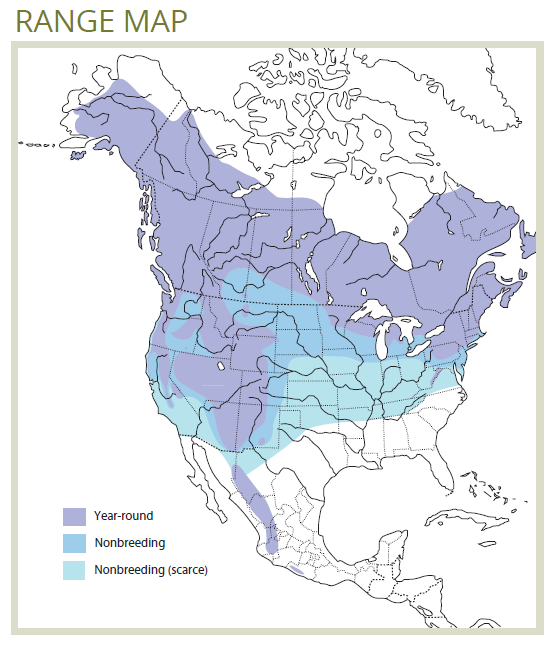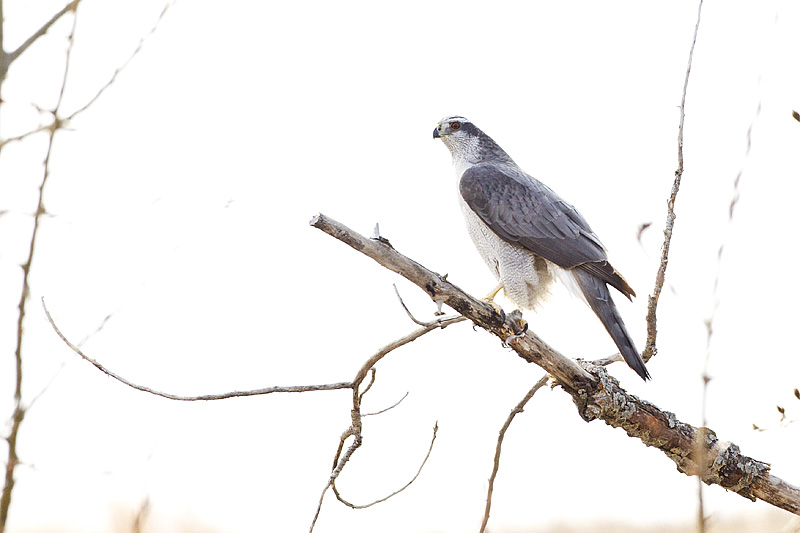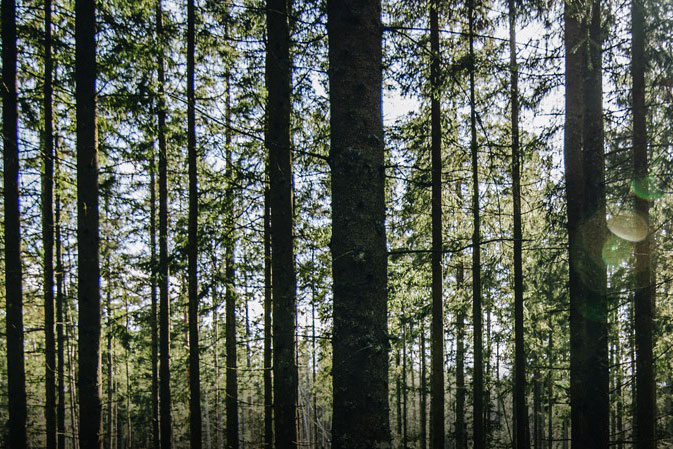Adult Northern Goshawks are immediately recognizable by their bold plumage and bright red eyes. They live across most of North America and occupy Canadian forests year-round.
Northern Goshawk
(Accipiter gentilis [atricapillus subspecies])
Habitat Ecology
- Northern Goshawks live across a wide range of forest types, but are most common in mature and old forests, particularly coniferous stands where they are available.1
- This species uses habitat at multiple scales:
- “Nest site” is the 1-ha area surrounding the nest. It generally contains large diameter trees (e.g., aspen ~30 cm dbh) and has high canopy closure (>60%).2
- “Nest area” is the 8–20 ha area around the nest. It contains >50% mature/old forest and alternate nest trees.3
- “Post-fledging area” is the 120–240 ha area around the nest. It contains alternate high amounts of mature/old forest, nest stands, snags, downed logs, and a well-developed understory that provides cover for flightless young.3,4
- “Foraging area” is the >1,000 ha area around the nest. It may contain more early- to mid-seral forest, but ideally contains >60% forest area >80 years old.3,5
- The Northern Goshawk’s breeding period begins in February/March, meaning winter operations have an increased risk of incidental take or disruption of nests and/or fledglings.6,7

Response to Forest Management
- The Northern Goshawk’s close association with mature/old forest makes it sensitive to forest harvesting, which may reduce habitat quality by removing nest trees, opening the canopy, and promoting understory closure.1
- This species’ responses to harvesting have been mixed but are generally characterized by lower occupancy of harvested areas. Reproductive success does not appear to be affected by harvesting.8
Stand-level Recommendations
- While there is some evidence that nest-tree buffers may be effective9, they fail to maintain habitat at larger scales (see Landscape-level Recommendations).4
- Where harvesting cannot be avoided near known Northern Goshawk nests, the following precautions are recommended:6
- Operators should place 500–1,000 m no-work zones around active nests from Feb.15 to Aug.15.
- Nests should be buffered by at least 100 m (preferably >200 m), and these patches should be designed to reduce edge.
Landscape-level Recommendations
- NRV targets for mature and old forest (closed canopy, >80 years old) are recommended to be concentrated in large, continuous stands within the breeding area where possible. The total amount of old forest should be at least 25 ha but preferably >100 ha or more to provide greatest benefit to this species.6
- Steep slope areas left unharvested are not considered to contribute to nesting habitat for this species, as Northern Goshawk typically nests on gentle slopes (<40%).10
- Where harvest occurs, the maintenance of several old stands >12 ha within the 120–240 ha area around the nest may be beneficial, provided they have closed canopies and multiple vegetation layers. The effectiveness of this strategy requires testing, and contiguous forest is preferred to isolated patches.11
References
- Squires, J. R. & Reynolds, R. T. 1997. Northern Goshawk (Accipiter gentilis), version 2.0. in The Birds of North America (Rodewald, P. G., ed.) Cornell Lab of Ornithology, Ithaca, New York, USA.
- McGrath, M. T., DeStefano, S., Riggs, R. A., Irwin, L. L. & Roloff, G. J. 2003. Spatially explicit influences on northern goshawk nesting habitat in the interior Pacific Northwest. Wildlife Monographs 154: 1–63. Available online: http://www.jstor.org/stable/3830854
- Cooper, J. M. & Stevens, V. 2000. A review of the ecology, management and conservation of the northern goshawk in British Columbia. B.C. Minist. Environ., Lands and Parks, Wildl. Branch, Victoria, BC. Wildlf. Bull. No. B-101. 31 pp.
- Harrower, W. L., Larsen, K. W. & Stuart-Smith, A. K. 2010. Movements and resource selection of fledgling goshawks in montane forests of southeastern British Columbia. Journal of Wildlife Management 74: 1768–1775. Available online: http://onlinelibrary.wiley.com/doi/10.2193/2009-127/abstract
- B.C. Conservation Data Centre. 2018. Conservation Status Report: Accipiter gentilis atricapillus. B.C. Minist. of Environment Available online: http://a100.gov.bc.ca/pub/eswp/
- Stuart-Smith, A. K., Harrower, W. L., Mahon, T., McClaren, E. I. & Doyle, F. I. 2012. A scientific basis for managing northern goshawk breeding areas in the interior of British Columbia: Best management practices. FORREX Forum for Research and Extension in Natural Resources, Kamloops, B.C. FORREX Series 29. Available online: http://www.forrex.org/sites/default/files/forrex_series/176-goshawk-fina…
- Takats Priestley, L. 2005. Northern Goshawk and Barred Owl nesting Phenology in central Alberta. Nature Alberta 35: 10–12.
- Rodriguez, S. A., Kennedy, P. L. & Parker, T. H. 2016. Timber harvest and tree size near nests explains variation in nest site occupancy but not productivity in northern goshawks (Accipiter gentilis). Forest Ecology and Management 374: 220–229. Available online: http://dx.doi.org/10.1016/j.foreco.2016.04.052
- Mahon, T. & Doyle, F. I. 2005. Effects of timber harvesting near nest sites on the reproductive success of Northern Goshawks (Accipiter gentilis). Journal of Raptor Research 39: 335–341.
- Penteriani, V. 2002. Goshawk nesting habitat in Europe and North America: a review. Ornis Fennica 79: 149–163. Available online: http://www.vincenzopenteriani.org/publications_pdfs/accipiter_gentilis_o…
- Daw, S. K. & DeStefano, S. 2001. Forest characteristics of northern goshawk nest stands and post-fledgling areas in Oregon. The Journal of Wildlife Management 65: 59–65. Available online: http://www.jstor.org/stable/pdf/3803277.pdf?seq=1#page_scan_tab_contents








